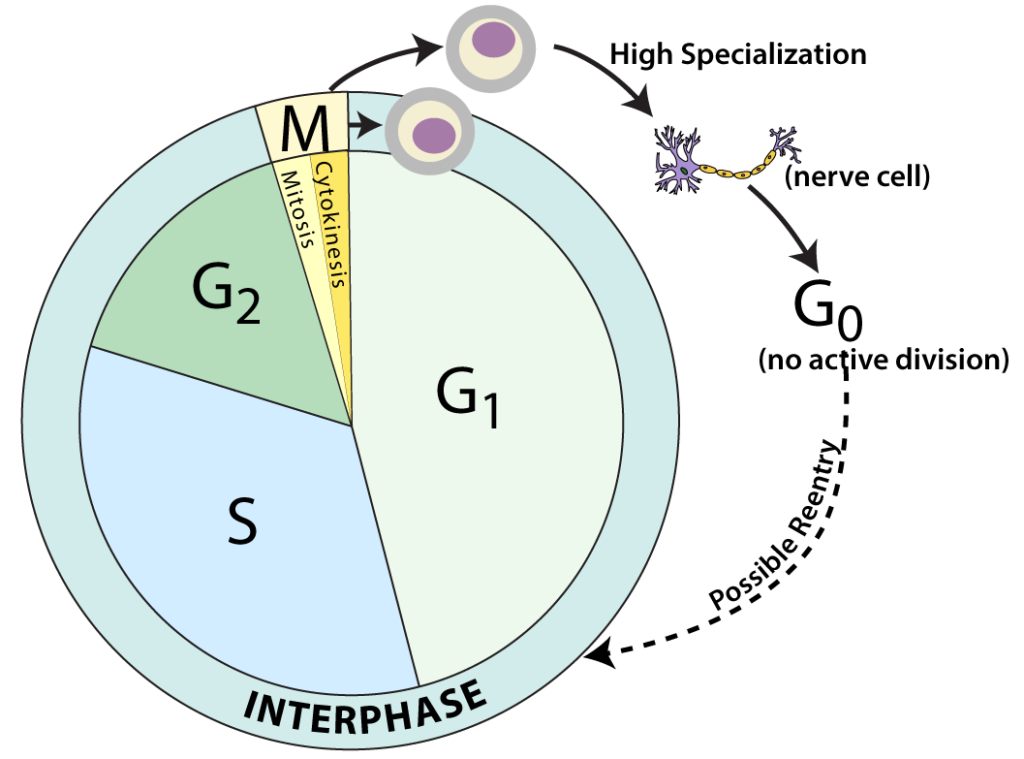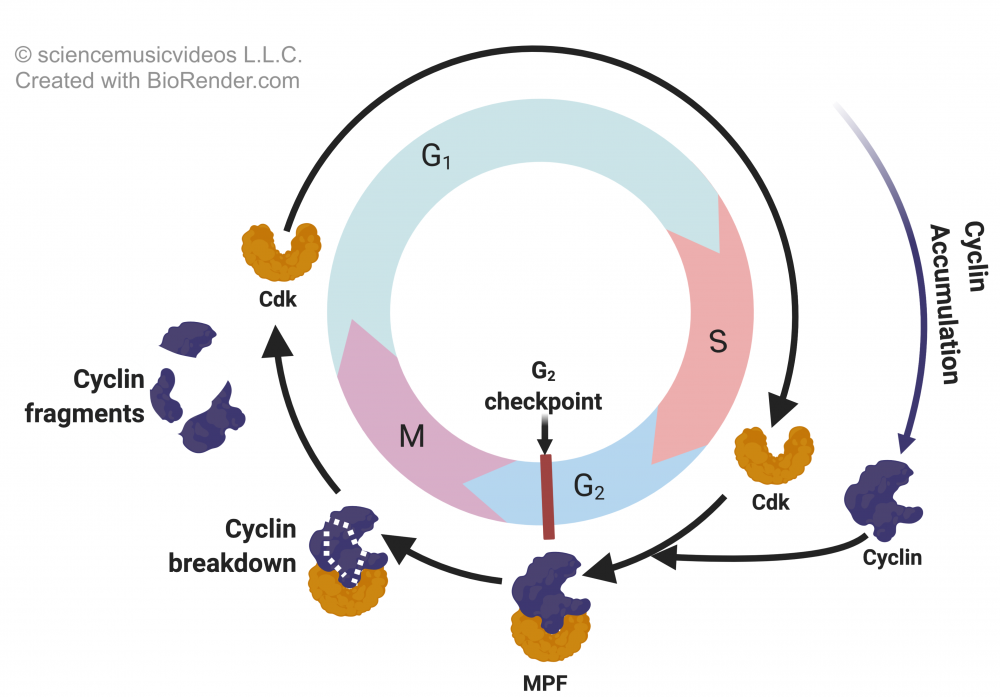Looking for a student learning guide? It’s linked in the main menu for your course. Use the “Courses” menu above.
1. Some cells never divide…how do they know not to?
 One important thing to know about the cell cycle is that many of your cells (billions of them) don’t divide at all. Specialized cells like neurons (nerve cells) or muscle cells, once they reach maturity, leave the cell cycle, never to divide again.
One important thing to know about the cell cycle is that many of your cells (billions of them) don’t divide at all. Specialized cells like neurons (nerve cells) or muscle cells, once they reach maturity, leave the cell cycle, never to divide again.
You can see this in the diagram on the right. This non-dividing phase, an alternative to G1, is referred to as G0. And while that’s a permanent condition for nerve and muscle cells, it’s more conditional for other cells. Liver cells, for example, won’t divide unless there’s some injury to the liver. In response, liver cells will leave G0 and re-enter the cell cycle.
2. It’s about molecular influences
[qwiz repeat_incorrect=”false” qrecord_id=”sciencemusicvideosMeister1961-Cell Fusion Experiments, I.R.”] [h]
Cell Fusion Experiments by Rao and Johnson
[q] In their first experiment, a cell that was in S phase was fused with a cell in G1. What do you think happened?
[c]IA ==IFNob3cgdGhlIGFuc3dlcg==[Qq]
[f]IEhlcmUmIzgyMTc7cyB0aGUgcmVzdWx0LiBUaGUgRw==MQ==IGNlbGwgaW1tZWRpYXRlbHkgZW50ZXJlZCBTIHBoYXNlLg==
Cg==[Qq]
If you’ve been studying biology since the start of this school year, you’re probably far enough along in your thinking about biology to begin speculating about a mechanism. So, ask yourself, what could be happening? But, before addressing that, take a look at a second experiment.
Click “Got it” to continue.
[q] In this experiment, a cell in M phase was fused with a cell in G1. Predict what happened.
[c]IA ==IFNob3cgdGhlIGFuc3dlcg==[Qq]
[f]VGhlIGNlbGwgdGhhdCB3YXMgaW4gRw==MQ==IHN0YXJ0ZWQgdG8gYnVpbGQgYSBzcGluZGxlLCBldmVuIHRob3VnaCBpdCBoYWRuJiM4MjE3O3QgcGFzc2VkIHRocm91Z2ggdGhlIFMgcGhhc2Ugb2YgdGhlIGNlbGwgY3ljbGUu
Cg==[Qq]
Click “Got it” to continue.
[q labels = “top”]Notice the pattern. It’s always the cell that’s ___________ along in the cell cycle that determines what happens in the second cell. Rao and Johnson concluded that ____________ in the ________________ of the more “mature” cell triggered changes in the ______ mature cell. Hold onto this idea as we move forward with this tutorial.
[l]cytoplasm
[f*] Excellent!
[fx] No. Please try again.
[l]further
[f*] Correct!
[fx] No. Please try again.
[l]less
[f*] Good!
[fx] No, that’s not correct. Please try again.
[l]molecules
[f*] Great!
[fx] No. Please try again.
[x]Remember that it was molecules in the more mature cell that triggered changes in the less mature cell.
[/qwiz]
3. Cell Cycle Checkpoints

So far, no surprises: cell division (like almost all processes that happen inside cells) is regulated by the presence of certain molecules. Over the course of the cell cycle, the rise and fall of the concentration of these molecules trigger the cell’s progress from one phase of the cycle to the next.
A useful way to imagine this is to think of the cell as having checkpoints. You’ve probably seen checkpoints in movies. They’re stopping points along a road, usually monitored by armed guards. The guards check your credentials and decide if you’re qualified to pass. Checkpoint Charlie, shown above, was a famous checkpoint between East Germany and West Germany during the Cold War years when Germany was a divided nation. Now, it’s a popular tourist destination.
Cell cycle checkpoints are moments when the cell can “check” its internal conditions and “decide” whether to progress to the next phase of the cell cycle. If certain molecules are in the right concentration, the cell will continue along the cell cycle. If not, the cell cycle pauses, moving the cell into G0 or, in certain cases, initiating a process called apoptosis (programmed cell death).
There are three primary checkpoints in the cell cycle: one during G1, the second during G2, and the third during M. (“1,” “2,” and “3”, respectively, below).
[qwiz qrecord_id=”sciencemusicvideosMeister1961-Cell Cycle Checkpoints Quiz 1″]
[h]Cell Cycle Checkpoints Quiz 1
[q]Just to be sure you’re following: which of the checkpoints below determines whether a cell will progress from G1 into S?
[textentry single_char=”true”]
[c]MQ ==[Qq]
[f]Q29ycmVjdC4gQ2hlY2twb2ludCAxIChrbm93biBhdCB0aGUgRw==MQ==IGNoZWNrcG9pbnQpIGNoZWNrcyBmb3IgdGhpbmdzIGxpa2Ugd2hldGhlciB0aGUgY2VsbCBoYXMgZ3Jvd24gdG8gYW4gYXBwcm9wcmlhdGUgc2l6ZSwgb3IgaWYgbnV0cmllbnQgbGV2ZWxzIGFyZSBjb3JyZWN0LiBJZiB0aGV5IGhhdmUsIHRoZSBjZWxsIHByb2dyZXNzZXMgaW50byBTIHBoYXNlLCB3aGVyZSBETkEgaXMgc3ludGhlc2l6ZWQu[Qq]
[c]Kg==[Qq]
[f]Tm8uIEhlcmUmIzgyMTc7cyBhIGhpbnQuIEZpbmQgdGhlIGNoZWNrcG9pbnQgdGhhdCYjODIxNztzIGxvY2F0ZWQgYmVmb3JlIFMgKEROQSBzeW50aGVzaXMpIGJlZ2lucy4=[Qq]
[q]Which of the checkpoints below most likely checks for the proper synthesis of DNA before the cell proceeds with dividing up its nucleus?
[textentry single_char=”true”]
[c]Mg ==[Qq]
[f]Q29ycmVjdC4gQ2hlY2twb2ludCAyIGNoZWNrcyBmb3Igd2hldGhlciBETkEgaGFzIGJlZW4gcmVwbGljYXRlZCBiZWZvcmUgYWxsb3dpbmcgdGhlIGNlbGwgdG8gcHJvY2VlZCBpbnRvIGRpdmlkaW5nIHVwIHRoYXQgRE5BIGludG8gZWFjaCBkYXVnaHRlciBjZWxsLg==[Qq]
[c]Kg==[Qq]
[f]Tm8uIEhlcmUmIzgyMTc7cyBhIGhpbnQuIEZpbmQgdGhlIGNoZWNrcG9pbnQgdGhhdCYjODIxNztzIGFmdGVyIFMgKEROQSBzeW50aGVzaXMpLCBidXQgYmVmb3JlIG1pdG9zaXMu[Qq]
[x]Continue reading below.
[/qwiz]
4. Cyclins and Cyclin-Dependent Kinases interact to regulate the cell cycle
Two types of molecules that are used by cells to enable them to move through the cell cycle are cyclins and cyclin-dependent kinases. Cyclins are a family of molecules whose concentration oscillates (goes up and down) throughout the course of the cell cycle.
[qwiz]
[q] Here’s a one-question quiz. Study the diagram below for a moment, and make note of when these various cyclins are peaking during the phases of the cell cycle. Which cyclin seems to be the immediate trigger for mitosis? Type in D, E, A, or B into the box below.
[textentry single_char=”true”]
[c]Qg ==[Qq]
[f]VGhhdCBtYWtlcyBzZW5zZS4gTGV2ZWxzIG9mIGN5Y2xpbiBCIGFyZSBwZWFraW5nIHZlcnkgY2xvc2UgdG8gd2hlbiBtaXRvc2lzIHN0YXJ0cy4=
Cg==UmVhZCBiZWxvdyB0byBjb250aW51ZS4=[Qq]
[c]Kg==[Qq]
[f]Tm8uIEl0JiM4MjE3O3MgY3ljbGluICYjODIyMDtCJiM4MjIxOywgdGhlIG9uZSB3aG9zZSBwZWFrIGlzIHJpZ2h0IGF0IHRoZSBzdGFydCBvZiBtaXRvc2lzLg==
Cg==UmVhZCBiZWxvdyB0byBjb250aW51ZS4=[Qq]
[/qwiz]

As you learned in our tutorial about signal transduction, kinases are enzymes that activate other molecules (often other enzymes) by phosphorylating them. Phosphorylation involves adding a phosphate group. This changes the 3-D shape of a molecule, and if that change involves the active site of an enzyme, then we have a mechanism for turning enzyme activity on and off through allosteric regulation (where binding of a molecule at a binding site that’s away from an enzyme’s active site changes the active site).
Cyclin-dependent kinases, as you can tell by the name, are kinases whose activity depends on the concentration of cyclins. One of the first cyclin-dependent kinases to be studied was MPF, a molecule first discovered in frog eggs that promotes the entrance of cells into M phase from G2. MPF was originally studied in the context of frog development and stands for Maturation Promoting Factor. However, if you think of it as mitosis-promoting factor, it might assist you in remembering what this molecule does.
[qwiz qrecord_id=”sciencemusicvideosMeister1961-Cyclin and MPF”]
[h]Cyclin and MPF
[q multiple_choice=”true”] A dramatic rise in MPF seems to be the trigger for initiation of …
[c]IEc=McKg[Qq][c]IFMg[Qq][c]IEc=MsKg[Qq][c]IE 0=
Cg==[Qq][f]IE5vLiBKdXN0IGZpbmQgdGhlIHBoYXNlIHdoZXJlIE1QRiBpcyBhdCBpdHMgaGlnaGVzdCBsZXZlbC4=[Qq]
[f]IE5vLiBKdXN0IGZpbmQgdGhlIHBoYXNlIHdoZXJlIE1QRiBpcyBhdCBpdHMgaGlnaGVzdCBsZXZlbC4=[Qq]
[f]IE5vLiBKdXN0IGZpbmQgdGhlIHBoYXNlIHdoZXJlIE1QRiBpcyBhdCBpdHMgaGlnaGVzdCBsZXZlbC4=[Qq]
[f]IENvcnJlY3QuIFlvdSBjYW4gc2VlIHRoYXQgTVBGIGFjdGl2aXR5IGRyYW1hdGljYWxseSByaXNlcyBhdCB0aGUgc3RhcnQgb2YgTSBwaGFzZSAoYW5kIHRoYXQgaXQmIzgyMTc7cyBhdCB6ZXJvIGR1cmluZyB0aGUgb3RoZXIgcGhhc2VzIG9mIHRoZSBjZWxsIGN5Y2xlLg==[Qq]
[q multiple_choice=”true”] Which of the statements below seems to make the most sense?
[c]QSByaXNlIGluIE1QRiBhY3Rpdml0eSB0cmlnZ2VycyBhIHJpc2UgaW4gbGV2ZWxzIG9mIG1pdG90aWMgY3ljbGlu[Qq]
[f]Tm8uIFdoZW4gTVBGIGxldmVscyBwZWFrLCB0aGUgbGV2ZWwgb2YgbWl0b3RpYyBjeWNsaW4gZmFsbHMgdG8gaXRzIGxvd2VzdCBsZXZlbC4=[Qq]
[c]QSByaXNlIGluIG1pdG90aWMgY3ljbGluIHRyaW dnZXJzIGEgcmlzZSBpbiBNUEYgYWN0aXZpdHku[Qq]
[f]IFllcy4gVGhlIGhpZ2hlc3QgbGV2ZWxzIG9mIGN5Y2xpbiBhcmUgYXNzb2NpYXRlZCB3aXRoIHRoZSBzcGlrZSBpbiBNUEYgYWN0aXZpdHkgdGhhdCBvY2N1cnMgZHVyaW5nIE0gcGhhc2Uu[Qq]
[c]QSBkcm9wIGluIG1pdG90aWMgY3ljbGluIHRyaWdnZXJzIGEgcmlzZSBpbiBNUEYgYWN0aXZpdHku[Qq]
[f]Tm8uIExvb2sgYXQgdGhlIGRpYWdyYW0uIFdoZW4gbWl0b3RpYyBjeWNsaW4gZHJvcHMsIE1QRiBhY3Rpdml0eSBmYWxscyB0byB6ZXJvLg==[Qq]
[x]Read below to continue
[/qwiz]
To see how the rise and fall of cyclin influence the cell cycle, let’s follow the diagram below.
MPF is a molecular complex that consists of a cyclin that’s bound to a CDK (cyclin-dependent kinase). As you can see on the left, these two only combine to form MPF for a brief moment (during M phase).
The CDK level stays constant throughout the cell cycle (reference: Nature.com). As we’ve seen, what fluctuates are the levels of cyclin. In the case of Cyclin B, its level rises from its lowest level during G1 and peaks during M. As cyclin levels rise, more and more cyclin binds with CDK, creating MPF. When MPF levels rise to their peak, the cell can pass the G2 checkpoint, allowing the cell to move into M phase, during which mitosis and cytokinesis occur.
During anaphase, cyclin (while still attached to MPF) is broken down. This renders MPF into its inactive form (CDK), and it will remain in that form until cyclin B again accumulates during the next cell cycle. Similar fluctuations in the levels of other cyclins are at work in controlling the move past the G1 checkpoint into S phase. At the M checkpoint, the cell “reads” levels of a protein complex that only forms when the spindle is attached to each and every chromosome at their kinetochores. This signal allows cells to proceed from metaphase to anaphase, moving towards the completion of mitosis.
5. A Cell Cycle Regulation Quiz
Try interacting with this diagram a bit so you can really understand what’s going on.
[qwiz random = “true” qrecord_id=”sciencemusicvideosMeister1961-Cell Cycle Regulation”] [h]
Cell Cycle Regulation
[i]
[q] If, in the diagram below, “2” is cyclin, then which number must be cyclin-dependent kinase?
[textentry single_char=”true”]
[c]ID M=[Qq]
[f]IEdyZWF0ISBZb3UgY2FuIGlkZW50aWZ5IENESyBpbiB0d28gd2F5czogMSkgYnkgdGhlIGZhY3QgdGhhdCBpdCYjODIxNztzIHByZXNlbnQgdGhyb3VnaG91dCB0aGUgZW50aXJlIGNlbGwgY3ljbGUsIGFuZCAyKSBieSB0aGUgZmFjdCB0aGF0IGl0IGNvbWJpbmVzIHdpdGggY3ljbGluIHRvIGZvcm0gTVBGLg==[Qq]
[c]ICo=[Qq]
[f]IE5vLiBIZXJlJiM4MjE3O3MgYSBoaW50LiBDeWNsaW4tZGVwZW5kZW50IGtpbmFzZSAoQ0RLKSBpcyBwcmVzZW50IGF0IGEgZmFpcmx5IGNvbnN0YW50IGNvbmNlbnRyYXRpb24gdGhyb3VnaG91dCB0aGUgY2VsbCBjeWNsZS7CoCBMb29rIGZvciBhIG1vbGVjdWxlIHdob3NlIGNvbmNlbnRyYXRpb24gc2VlbXMgdG8gZml0IHRoYXQgZGVzY3JpcHRpb24u[Qq]
[q] In the diagram below, which number represents the G2 checkpoint?
[textentry single_char=”true”]
[c]ID Q=[Qq]
[f]IENvcnJlY3QhICYjODIyMDs0JiM4MjIxOyBpcyB0aGUgRw==Mg==IGNoZWNrcG9pbnQuwqA=[Qq]
[c]Kg==[Qq]
[f]IE5vLiBIZXJlJiM4MjE3O3MgYSBoaW50LiBMb29rIGZvciBzb21ldGhpbmcgaW4gdGhlIGRpYWdyYW0gdGhhdCBpbmRpY2F0ZXMgYSBibG9jayBpbiB0aGUgY2VsbCBjeWNsZSwgb2NjdXJyaW5nIGR1cmluZyBHMg==Lg==[Qq]
[q] In the diagram below, which number represents cyclin-dependent kinase?
[textentry single_char=”true”]
[c]ID M=[Qq]
[f]IEV4Y2VsbGVudC4gWW91IGNhbiBpZGVudGlmeSBjeWNsaW4tZGVwZW5kZW50IGtpbmFzZSAoQ0RLKSBiZWNhdXNlIGl0IGlzIGEgbW9sZWN1bGUgdGhhdCBpcyBwcmVzZW50IGF0IGZhaXJseSBjb25zdGFudCBjb25jZW50cmF0aW9ucyB0aHJvdWdob3V0IHRoZSBjZWxsIGN5Y2xlICh1bmxpa2UgY3ljbGluICgmIzgyMjA7MiYjODIyMTspIHdoaWNoIHJpc2VzIGFuZCBmYWxscyB0aHJvdWdob3V0IHRoZSBjZWxsIGN5Y2xlKS4=[Qq]
[c]ICo=[Qq]
[f]IE5vLiBIZXJlJiM4MjE3O3MgYSBoaW50LiBZb3UgY2FuIGlkZW50aWZ5IGN5Y2xpbi1kZXBlbmRlbnQga2luYXNlIChDREspIGJlY2F1c2UgaXQgaXMgYSBtb2xlY3VsZSB0aGF0IGlzIHByZXNlbnQgYXQgZmFpcmx5IGNvbnN0YW50IGNvbmNlbnRyYXRpb25zIHRocm91Z2hvdXQgdGhlIGNlbGwgY3ljbGUuIFdoYXQgbW9sZWN1bGUgZml0cyB0aGF0IGRlc2NyaXB0aW9uPw==[Qq]
[q] In the diagram below, which number represents MPF?
[textentry single_char=”true”]
[c]ID U=[Qq]
[f]IEV4Y2VsbGVudDogQ3ljbGluIChhdCAmIzgyMjA7MiYjODIyMTspIGFuZCBjeWNsaW4tZGVwZW5kZW50IGtpbmFzZSAoYXQgJiM4MjIwOzMmIzgyMjE7KSBjb21lIHRvZ2V0aGVyIHRvIGZvcm0gTVBGLCB3aGljaCBpcyBzaG93biBhdCA1Lg==[Qq]
[c]ICo=[Qq]
[f]IE5vLiBIZXJlJiM4MjE3O3MgYSBoaW50LiBNUEYgaXMgZm9ybWVkIGJ5IGEgY29tYmluYXRpb24gb2YgY3ljbGluIGFuZCBjeWNsaW4tZGVwZW5kZW50IGtpbmFzZS4gV2hpY2ggaW1hZ2Ugb24gdGhlIGRpYWdyYW0gY291bGQgcmVwcmVzZW50IGEgbW9sZWN1bGUgYnVpbHQgb2YgdHdvIHN1YnVuaXRzPw==[Qq]
[q] If, in the diagram below, “3” is cyclin-dependent kinase, then which number must be cyclin?
[textentry single_char=”true”]
[c]ID I=[Qq]
[f]IE5pY2Ugam9iLiBOdW1iZXIgMiBpcyBjeWNsaW4u[Qq]
[c]ICo=[Qq]
[f]IE5vLiBIZXJlJiM4MjE3O3MgYSBoaW50LiBDeWNsaW4gcmlzZXMgYW5kIGZhbGxzIGluIGNvbmNlbnRyYXRpb24gZHVyaW5nIHRoZSBjZWxsIGN5Y2xlLsKgIExvb2sgZm9yIGEgbW9sZWN1bGUgd2hvc2UgY29uY2VudHJhdGlvbiBzZWVtcyB0byBmaXQgdGhhdCBkZXNjcmlwdGlvbi4=[Qq]
[q] During M phase, cyclin disintegrates, changing MPF back to cyclin-dependent kinase (CDK). Which number shows MPF changing back into CDK as cyclin disintegrates?
[textentry single_char=”true”]
[c]ID Y=[Qq]
[f]IEF3ZXNvbWUuIE51bWJlciAmIzgyMjA7NiYjODIyMTsgc2hvd3MgdGhlIGN5Y2xpbiBwb3J0aW9uIG9mIE1QRiBkaXNpbnRlZ3JhdGluZywgY2hhbmdpbmcgTVBGIGJhY2sgaW50byBDREsu[Qq]
[c]ICo=[Qq]
[f]IE5vLiBIZXJlJiM4MjE3O3MgYSBoaW50LiBNUEYgaXMgY29tcG9zZWQgb2YgdHdvIHN1YnVuaXRzLiBPbmUgaXMgY3ljbGluIChhdCAmIzgyMjA7MiYjODIyMTspLiBXaGljaCBudW1iZXIgc2hvd3MgYSBtb2xlY3VsZSBtYWtlIG9mIHR3byBzdWJ1bml0cywgb25lIG9mIHdoaWNoIGlzIGZhbGxpbmcgYXBhcnQ/[Qq]
[q] Molecule 3 can be referred to by which 3-letter acronym?
[hangman]
[c]IENESw==[Qq]
[f]IEdyZWF0IQ==[Qq]
[q] Molecule 2 is
[hangman]
[c]IGN5Y2xpbg==[Qq]
[f]IEdvb2Qh[Qq]
[q] Molecule 5 can be referred to by the 3 letter acronym
[hangman]
[c]IE1QRg==[Qq]
[f]IEV4Y2VsbGVudCE=[Qq]
[q] Molecule 3 is known as cyclin-dependent [hangman].
[c]IGtpbmFzZQ==
[f]IEV4Y2VsbGVudCE=[Qq]
[q] What molecule is disintegrating in number 6?
[hangman]
[c]IGN5Y2xpbg==[Qq]
[f]IEdvb2Qh[Qq]
[x]If you’re satisfied with your score, read below to complete this tutorial.
[restart]
[/qwiz]
5. Conclusion: Thinking about Mechanisms for a Cyclical Process
The key conceptual move, as a biology student, is to be able to see how this system enables the cell (which of course doesn’t have any consciousness or intention) to control its passage through the cell cycle every time it needs to divide. A new daughter cell will have very low cyclin levels, which includes the level of the cyclin we’ve been focused on, cyclin B. As the cell grows and it moves through G1, S, and G2, its level of cyclin B will rise. At a certain concentration of cyclin B, enough MPF is formed to enable the cell to enter M phase. But just at the same moment that the machinery for mitosis and cytokinesis is put into place, cyclin disintegrates. As a result, when the new daughter cells begin their independent existence, cyclin levels are once again very low…setting the stage for another cell cycle.
Note that in addition to these internal signals, external signals also influence cell division. For example, PDGF (platelet derived growth factor) stimulates a variety of cells to divide. Platelets are cell fragments that float around in the bloodstream and which participate in clotting blood and repairing wounds. Their release of PDGF stimulates nearby cells to divide, which promotes tissue regeneration and healing.
Links
- Proceed to Cancer and Apoptosis, the next tutorial this Cell Cycle and Cell Cycle Regulation Module.

